ignition Lancia Ypsilon 2002 Owner handbook (in English)
[x] Cancel search | Manufacturer: LANCIA, Model Year: 2002, Model line: Ypsilon, Model: Lancia Ypsilon 2002Pages: 191, PDF Size: 2.45 MB
Page 72 of 191

69
G
STARTING
THE ENGINEIf the engine does not start at the
first attempt, return the ignition key
toSTOPbefore trying to start the en-
gine again.
If warning light ¢remains lit to-
gether with the warning light
when the ignition key is at MAR,
turn the key to STOPand then to
MAR; if the warning light still re-
mains lit, try with the other keys pro-
vided with the car.
If you are still unable to start the en-
gine, follow the emergency startup
procedure (see “Emergency startup”
in the section “In an emergency”) and
go to the nearest LANCIA Dealer-
shipimmediately.
IMPORTANTDo not leave the ig-
nition key at MARwhen the engine is
off.
The ignition switch fits a safety de-
vice. If the engine does not start at the
first attempt, return the ignition key
toSTOPbefore trying to start the en-
gine again.
In a similar way, you will not be able
to turn the key from MARtoAVV
when the engine is running.It is dangerous to let the
engine run in a garage or
other closed area. The en-
gine consumes oxygen and gives
off carbon dioxide, carbon monox-
ide and other poisonous fumes.
Do not touch the high
voltage cables (spark plug
cables) when the engine is
running.
During the running-in
period do not push the car
up to its highest perfor-
mance (e.g. sudden accelerations,
very long drives at high speed,
sharp braking etc.)
PROCEDURE
IMPORTANTDo not press on the
accelerator before the engine is run-
ning.
1)Make sure the handbrake is up.
2)Put the gear lever into neutral.
3)Press the clutch pedal down to the
floor.
4)Turn the ignition key to AVVand
let it go the moment the engine starts.
4C068-089 ING 11-03-2008 11:59 Pagina 69
Page 73 of 191

70
G
HOW TO WARM UP
THE ENGINE AFTER
IT HAS JUST STARTED
– Begin to move forward slowly let-
ting the engine turn over at medium
revs. Do not accelerate abruptly.
– Do not push the engine to its limit
for the first few kilometres. You are
recommended to wait until the water
temperature has reached 50°C to
60°C (pointer moves slightly from its
initial position).
EMERGENCY STARTING
If the Lancia CODE system fails to
recognise the code transmitted by the
ignition key (warning lamp ¢on in-
strument panel lit with a fixed light),
you can start the engine by following
the emergency procedure using the
code written on the CODE card.
See the section “In an emergency”.STOPPING THE ENGINE
Turn the ignition key to STOPwhile
the engine is idling.
Remember that as long as
the engine is not running,
the brake booster and
power steering do not work. You
therefore have to use considerably
more effort on both the brake
pedal and the steering wheel.
Bump starting by push-
ing, towing or rolling
downhill must be avoided
at all costs. This way of starting
could cause a rush of fuel into the
catalytic exhaust pipe and damage
it beyond repair.
BUMP STARTING
A quick burst on the ac-
celerator before turning off
the engine serves ab-
solutely no practical purpose, and
wastes fuel.
IMPORTANTAfter a taxing drive it
is better to allow the engine to “catch
its breath” before turning it off by let-
ting it idle to allow the temperature in
the engine compartment to fall.
4C068-089 ING 11-03-2008 11:59 Pagina 70
Page 74 of 191
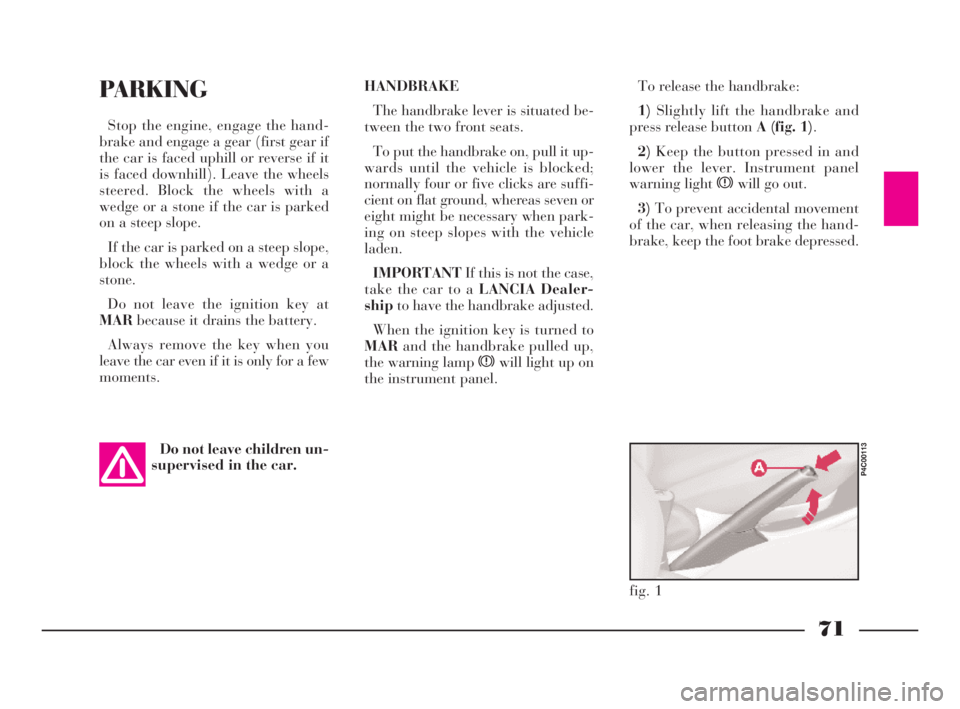
71
G
HANDBRAKE
The handbrake lever is situated be-
tween the two front seats.
To put the handbrake on, pull it up-
wards until the vehicle is blocked;
normally four or five clicks are suffi-
cient on flat ground, whereas seven or
eight might be necessary when park-
ing on steep slopes with the vehicle
laden.
IMPORTANTIf this is not the case,
take the car to a LANCIA Dealer-
shipto have the handbrake adjusted.
When the ignition key is turned to
MARand the handbrake pulled up,
the warning lamp xwill light up on
the instrument panel.To release the handbrake:
1)Slightly lift the handbrake and
press release button A (fig. 1).
2)Keep the button pressed in and
lower the lever. Instrument panel
warning light xwill go out.
3)To prevent accidental movement
of the car, when releasing the hand-
brake, keep the foot brake depressed.PARKING
Stop the engine, engage the hand-
brake and engage a gear (first gear if
the car is faced uphill or reverse if it
is faced downhill). Leave the wheels
steered. Block the wheels with a
wedge or a stone if the car is parked
on a steep slope.
If the car is parked on a steep slope,
block the wheels with a wedge or a
stone.
Do not leave the ignition key at
MARbecause it drains the battery.
Always remove the key when you
leave the car even if it is only for a few
moments.
Do not leave children un-
supervised in the car.
fig. 1
P4C00113
4C068-089 ING 11-03-2008 11:59 Pagina 71
Page 82 of 191
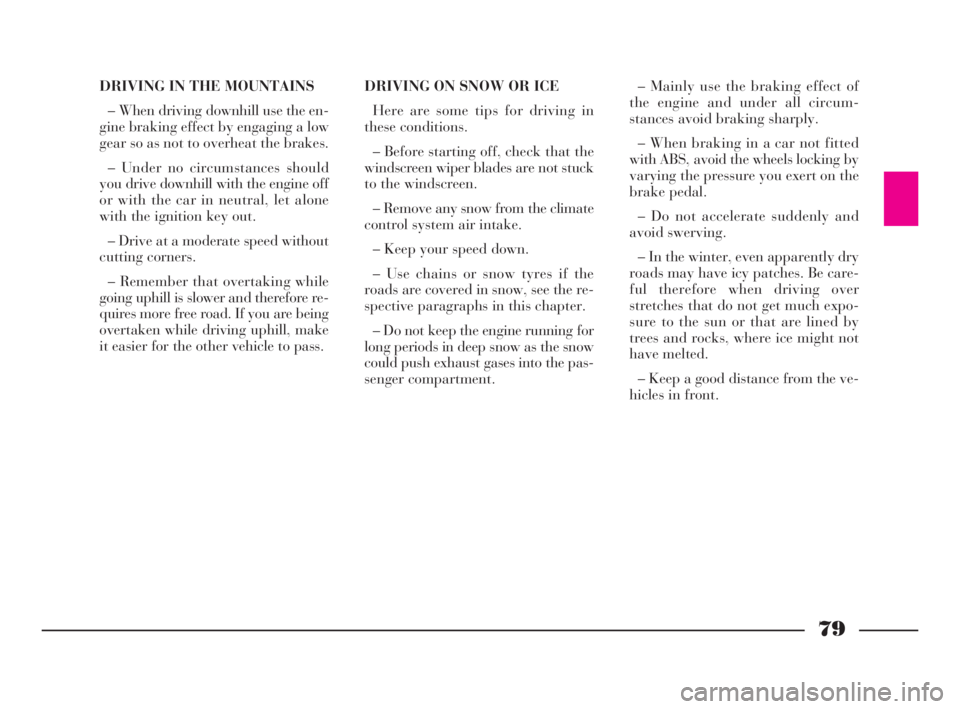
79
G
DRIVING IN THE MOUNTAINS
– When driving downhill use the en-
gine braking effect by engaging a low
gear so as not to overheat the brakes.
– Under no circumstances should
you drive downhill with the engine off
or with the car in neutral, let alone
with the ignition key out.
– Drive at a moderate speed without
cutting corners.
– Remember that overtaking while
going uphill is slower and therefore re-
quires more free road. If you are being
overtaken while driving uphill, make
it easier for the other vehicle to pass.DRIVING ON SNOW OR ICE
Here are some tips for driving in
these conditions.
– Before starting off, check that the
windscreen wiper blades are not stuck
to the windscreen.
– Remove any snow from the climate
control system air intake.
– Keep your speed down.
– Use chains or snow tyres if the
roads are covered in snow, see the re-
spective paragraphs in this chapter.
– Do not keep the engine running for
long periods in deep snow as the snow
could push exhaust gases into the pas-
senger compartment.– Mainly use the braking effect of
the engine and under all circum-
stances avoid braking sharply.
– When braking in a car not fitted
with ABS, avoid the wheels locking by
varying the pressure you exert on the
brake pedal.
– Do not accelerate suddenly and
avoid swerving.
– In the winter, even apparently dry
roads may have icy patches. Be care-
ful therefore when driving over
stretches that do not get much expo-
sure to the sun or that are lined by
trees and rocks, where ice might not
have melted.
– Keep a good distance from the ve-
hicles in front.
4C068-089 ING 11-03-2008 11:59 Pagina 79
Page 86 of 191

83
G
Traffic and road conditions
Heavy traffic and higher consump-
tion are synonymous; for example,
when driving slowly with frequent use
of the lower gears or in large towns
where there are numerous traffic
lights.
Winding roads, mountain roads and
bumpy roads also have a negative ef-
fect on consumption.
Enforced halts
During prolonged hold-ups (traffic
lights, level crossings) the engine
should be switched off.LOOKING AFTER EMISSION
CONTROL DEVICES
The correct use of pollution control
devices not only ensures respect for
the environment but also has an effect
on the car’s performance. Keeping
these devices in good condition is
therefore a fundamental rule for dri-
ving that is easy on your pocket and
on the environment too.
The first step to take is to follow the
Service Schedule to the letter.
Use only unleaded petrol.
If you have trouble starting, do not
keep turning the ignition key for long
periods. Be especially careful to avoid
bump starting the car by pushing,
towing or rolling down hill: these are
all manoeuvres that can damage the
catalytic exhaust.CHEAP RUNNING
THAT RESPECTS
THE ENVIRONMENT
Environmental protection has been
one of the guiding principles in the
production of the Lancia Y. It is no ac-
cident that its pollution control equip-
ment is much more effective than that
required by current legislation.
Nonetheless, the environment can-
not get by without a concerted effort
from everyone.
By following a few simple rules you
can avoid harming the environment
and often cut down fuel consumption
at the same time.
On this subject, a few useful tips
have been given below to supplement
those marked by symbol #at various
points of the handbook.
You are asked to read both the for-
mer and latter carefully.
4C068-089 ING 11-03-2008 11:59 Pagina 83
Page 94 of 191

91
G
EMERGENCY
STARTUP
If the ignition key fails to deactivate
the engine immobiliser, the warning
light¢will remain lit and the engine
will not start. In this case, you should
contact your LANCIA Dealership
and get them to carry out the emer-
gency startup using the code given on
the CODE card. Alternatively, you
can perform the emergency startup
procedure yourself by following the
procedure given below.
Read the whole procedure care-
fully before trying to carry it out.If
you make a mistake in the emergency
procedure you must turn the ignition
key back to STOPand repeat the
whole operation from the beginning
step1.
1)Read the 5-figure electronic code
given on the CODE card.
2)Turn the ignition key to MAR.
3)Press the accelerator pedal to the
floor and keep it there. The warning
lamp will light up for about 8
seconds, and then go out. At this point
release the accelerator pedal and pre-
pare to count the number of flashes of
the warning lamp .
4)The warning lamp starts
flashing: when it has
flashed the number of times that cor-
responds to the first figure of the code
on the CODE card, press the acceler-
ator pedal and keep it there until the
warning lamp lights up for four
seconds and then
goes out again. Release the accelera-
tor pedal.
5)The warning lamp will start
flashing again: when
the lamp has flashed the number of
times that corresponds to the second
figure on the CODE card, press the
accelerator pedal to the floor and keep
it there.
6)Do the same for the remaining
figures on the CODE card.
7)Once the final figure has been en-
tered, keep the accelerator pedal
pressed. The warning lamp will
light up for 4 seconds andthen go out. Release the accelerator
pedal.
4C090-119 ING 11-03-2008 12:00 Pagina 91
Page 95 of 191
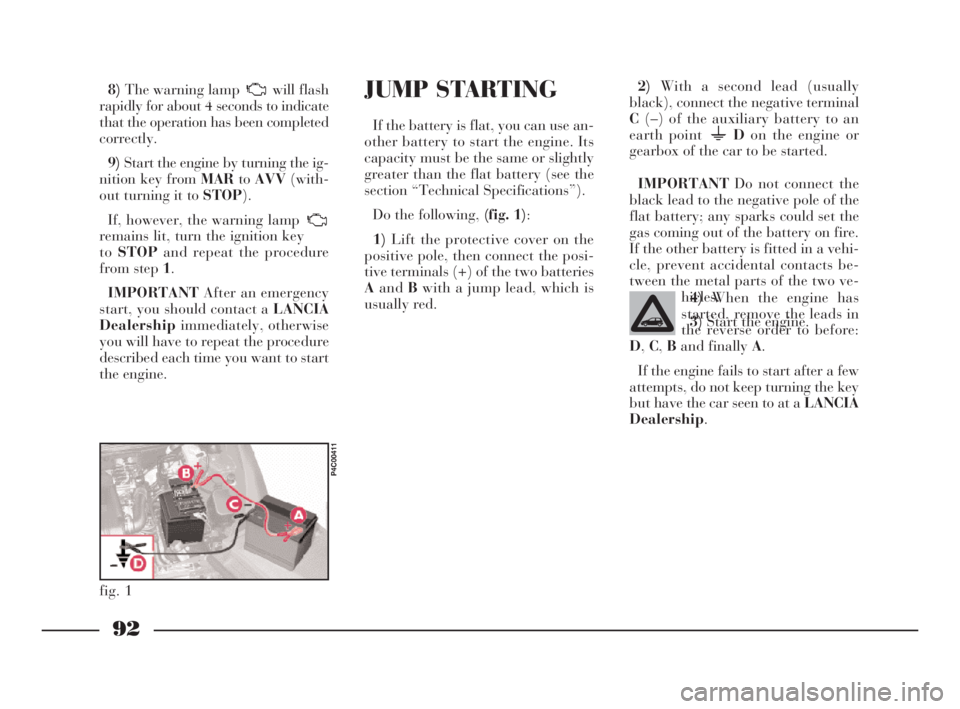
92
G
8)The warning lamp will flash
rapidly for about 4 seconds to indicate
that the operation has been completed
correctly.
9)Start the engine by turning the ig-
nition key from MARtoAVV(with-
out turning it to STOP).
If, however, the warning lamp
remains lit, turn the ignition key
toSTOPand repeat the procedure
from step 1.
IMPORTANTAfter an emergency
start, you should contact a LANCIA
Dealershipimmediately, otherwise
you will have to repeat the procedure
described each time you want to start
the engine.JUMP STARTING
If the battery is flat, you can use an-
other battery to start the engine. Its
capacity must be the same or slightly
greater than the flat battery (see the
section “Technical Specifications”).
Do the following, (fig. 1):
1)Lift the protective cover on the
positive pole, then connect the posi-
tive terminals (+) of the two batteries
AandBwith a jump lead, which is
usually red.2)With a second lead (usually
black), connect the negative terminal
C(–) of the auxiliary battery to an
earth point Don the engine or
gearbox of the car to be started.
IMPORTANTDo not connect the
black lead to the negative pole of the
flat battery; any sparks could set the
gas coming out of the battery on fire.
If the other battery is fitted in a vehi-
cle, prevent accidental contacts be-
tween the metal parts of the two ve-
hicles.
3)Start the engine.
4)When the engine has
started, remove the leads in
the reverse order to before:
D,C,Band finally A.
If the engine fails to start after a few
attempts, do not keep turning the key
but have the car seen to at a LANCIA
Dealership.
fig. 1
P4C00411
4C090-119 ING 11-03-2008 12:00 Pagina 92
Page 96 of 191

93
G
Under no circumstances
should a battery charger
be used to start the engine:
it could damage the electronic sys-
tems and in particular the control
units governing ignition and fuel
feed.Do not carry out this pro-
cedure if you lack experi-
ence; if it is not done cor-
rectly it can cause very intense
electrical discharges and the bat-
tery might even explode. In addi-
tion, the fluid contained in the bat-
tery is poisonous and corrosive.
Avoid contact with skin and eyes.
You are also advised not to putnaked flames or lighted cigarettes
near the battery and not to cause
sparks: risk of fire and explosion.
To avoid damage to the
electrical system, scrupu-
lously follow the cable
manufacturer’s instructions. Make
sure the cables have an adequate
cross section and are long enough
to avoid the two car touching.
4C090-119 ING 11-03-2008 12:00 Pagina 93
Page 115 of 191
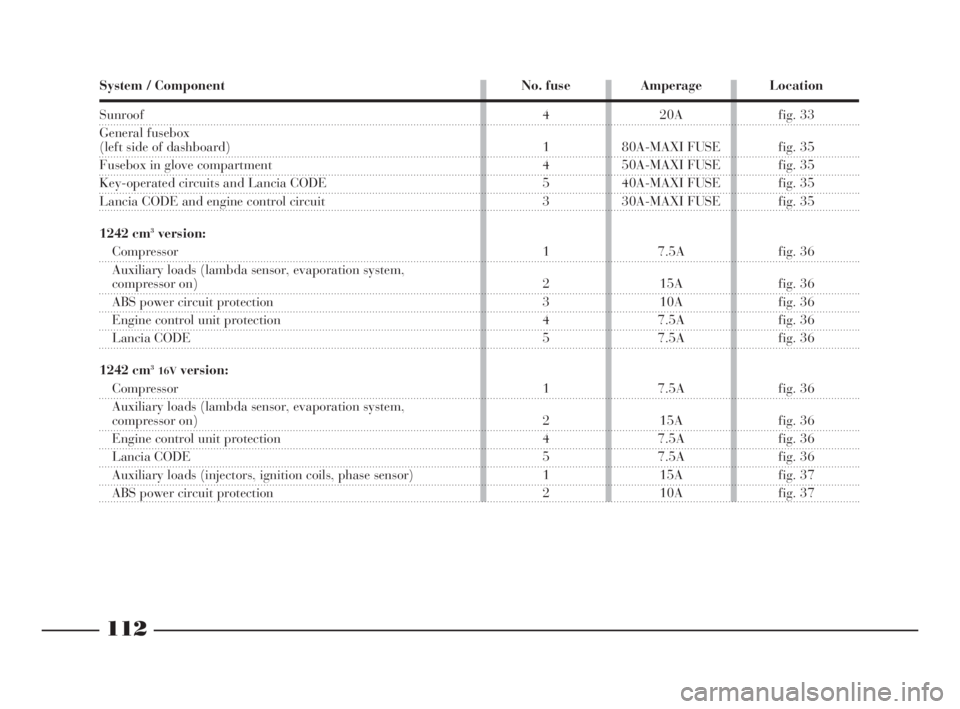
112
fG
System / Component No. fuse Amperage Location
Sunroof
General fusebox
(left side of dashboard)
Fusebox in glove compartment
Key-operated circuits and Lancia CODE
Lancia CODE and engine control circuit
1242 cm
3version:
Compressor
Auxiliary loads (lambda sensor, evaporation system,
compressor on)
ABS power circuit protection
Engine control unit protection
Lancia CODE
1242 cm
316Vversion:
Compressor
Auxiliary loads (lambda sensor, evaporation system,
compressor on)
Engine control unit protection
Lancia CODE
Auxiliary loads (injectors, ignition coils, phase sensor)
ABS power circuit protection4 20A fig. 33
1 80A-MAXI FUSE fig. 35
4 50A-MAXI FUSE fig. 35
5 40A-MAXI FUSE fig. 35
3 30A-MAXI FUSE fig. 35
1 7.5A fig. 36
2 15A fig. 36
3 10A fig. 36
4 7.5A fig. 36
5 7.5A fig. 36
1 7.5A fig. 36
2 15A fig. 36
4 7.5A fig. 36
5 7.5A fig. 36
1 15A fig. 37
2 10A fig. 37
les
00
ed
az-
ve
4C090-119 ING 13-03-2008 12:51 Pagina 112
Page 116 of 191
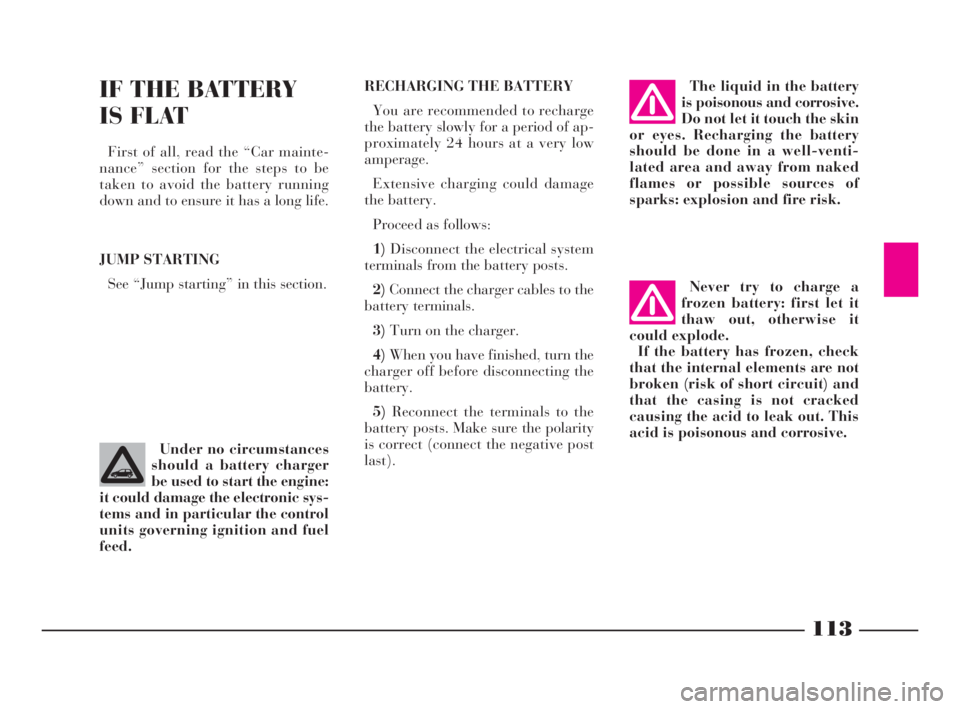
113
fG
RECHARGING THE BATTERY
You are recommended to recharge
the battery slowly for a period of ap-
proximately 24 hours at a very low
amperage.
Extensive charging could damage
the battery.
Proceed as follows:
1)Disconnect the electrical system
terminals from the battery posts.
2)Connect the charger cables to the
battery terminals.
3)Turn on the charger.
4)When you have finished, turn the
charger off before disconnecting the
battery.
5)Reconnect the terminals to the
battery posts. Make sure the polarity
is correct (connect the negative post
last).IF THE BATTERY
IS FLAT
First of all, read the “Car mainte-
nance” section for the steps to be
taken to avoid the battery running
down and to ensure it has a long life.
JUMP STARTING
See “Jump starting” in this section.The liquid in the battery
is poisonous and corrosive.
Do not let it touch the skin
or eyes. Recharging the battery
should be done in a well-venti-
lated area and away from naked
flames or possible sources of
sparks: explosion and fire risk.
Never try to charge a
frozen battery: first let it
thaw out, otherwise it
could explode.
If the battery has frozen, check
that the internal elements are not
broken (risk of short circuit) and
that the casing is not cracked
causing the acid to leak out. This
acid is poisonous and corrosive.
Under no circumstances
should a battery charger
be used to start the engine:
it could damage the electronic sys-
tems and in particular the control
units governing ignition and fuel
feed.
4C090-119 ING 13-03-2008 12:51 Pagina 113